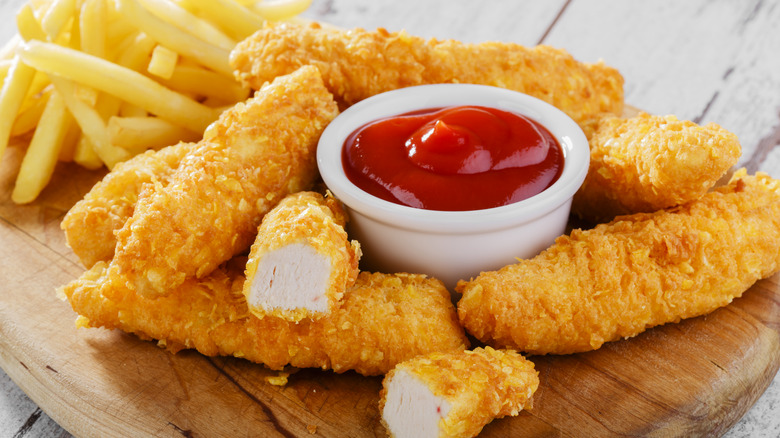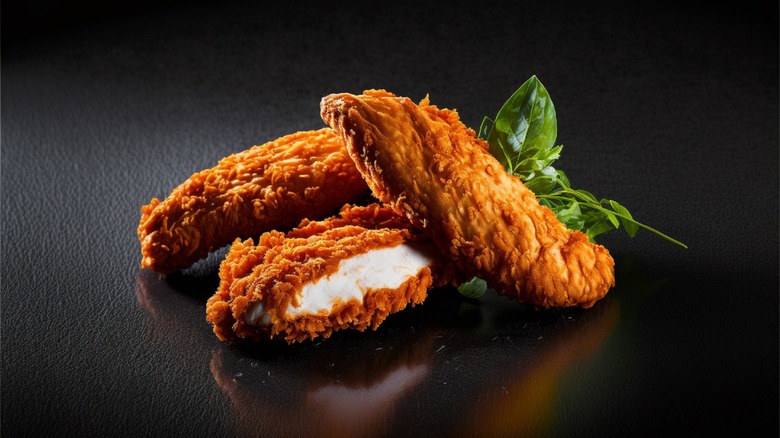Ever stared at your plate of chicken fingers and thought, “Wait a minute. chickens don’t have fingers!” You’re not alone. This delicious, dippable food has a curious name that’s become so common we rarely question it. But the history behind these golden strips is actually pretty fascinating!
As someone who’s researched food history for years, I’ve discovered that chicken fingers have a surprisingly interesting backstory. So let’s dive into why these tasty morsels ended up with such a peculiar name, and explore their journey from regional specialty to national favorite.
What Exactly Are Chicken Fingers?
Before we get into the name let’s clarify what we’re talking about
Chicken fingers (also known as chicken tenders, chicken strips, chicken goujons, or chicken fillets) are pieces of chicken meat that are:
- Usually cut from the pectoralis minor muscles (tenderloins) of chicken
- Located on either side of the breastbone, under the breast meat
- Breaded and deep-fried (typically)
- Shaped in long, thin strips
The genuine chicken tender comes specifically from the pectoralis minor muscle, but many restaurants and food producers make “chicken fingers” by simply cutting strips from regular chicken breast meat.
So… Why “Fingers”?
The most straightforward explanation for the name “chicken fingers” is simply their shape. These long, thin strips of breaded chicken vaguely resemble human fingers in their elongated form.
While chickens obviously don’t have fingers, the name creates an immediate visual cue about what you’re getting – slim strips of chicken meant to be eaten with your hands. The name is:
- Descriptive of their appearance
- Kid-friendly and fun
- Simple and memorable
- Easy to market
Some food historians suggest the “finger” part might also reference the fact they’re finger food – meant to be picked up and eaten without utensils. But most evidence points to the shape being the primary reason.
The Birthplace Debate: Who Invented Chicken Fingers?
The exact origins of chicken fingers are disputed, with several claims to their invention:
The New Hampshire Claim
According to the Wikipedia article, chicken tenders were first made at the Puritan Backroom in Manchester, New Hampshire in 1974. Charlie Pappas reportedly salvaged chicken pieces that had been trimmed from larger cuts, marinating and frying them to create the first chicken tenders.
This claim is so strongly established that in 2023, Manchester was officially declared the “Chicken Tender Capital of the World” by Mayor Joyce Craig.
Other Contenders
However, other restaurants have challenged this claim:
- Restaurants in Savannah, Georgia
- Establishments in Baton Rouge, Louisiana
- H.D. “Doc” Thornton, a restaurant owner in Kentucky, who supposedly invented them in the late 1950s
- Don M. Smith, a chef in Tennessee, who reportedly served similar fried chicken strips for easier eating while driving
The RedTableMeats article suggests they emerged in the late 1950s from several inventive culinary minds during the post-war era’s boom in automobiles and rise of fast food.
The Rise to Popularity
Chicken fingers didn’t become an overnight sensation. Their journey to ubiquity took several decades:
- 1950s-60s: Early versions appear in regional restaurants
- 1970s: The Puritan Backroom creates their version (calling them “tenders”)
- 1970s-80s: Fast food chains like McDonald’s and Burger King add breaded chicken strips to their menus
- 1990s: Chicken fingers secure their place in America’s culinary consciousness
Several factors helped propel chicken fingers to nationwide popularity:
- Fast food adoption – Nationwide chains introduced them to consumers across the country
- Food technology advancements – Enabled large-scale production of breaded frozen chicken fingers
- Growing convenience trend – Their portability and ease of eating matched changing American lifestyles
- Kid-friendly appeal – They became a staple on children’s menus everywhere
Regional Differences and Variations
While the basic concept stays consistent, chicken fingers have developed regional differences:
- Name variations: Some parts of the South still use “chicken tenders” instead of “fingers”
- Serving style: Midwest and Northeast often serve them as appetizers with dipping sauces, while the South may offer them as entrees with sides
- Breading differences: Panko breading is popular in the West/Southwest, while Southern versions tend to use cornmeal
The Puritan Backroom’s original chicken tenders were actually marinated in duck sauce, and similarly marinated “Manchester chicken tenders” can still be found at other restaurants in the Manchester area.
The Dipping Sauce Factor
No discussion of chicken fingers would be complete without mentioning their partner in crime: dipping sauces! Popular options include:
- Honey mustard
- Ranch dressing
- BBQ sauce
- Sweet and sour sauce
- Buffalo sauce
- Ketchup
The dippable nature of chicken fingers is part of what makes them so beloved – you can customize each bite with your favorite flavor!
Are They Healthy?
Let’s be real – traditional chicken fingers aren’t winning any nutrition awards. They’re typically breaded and deep-fried, often served alongside french fries.
However, healthier versions exist:
- Baked instead of fried
- Made with whole grain breading
- Air-fried variations
- Grilled chicken strips (though purists might argue these aren’t true chicken fingers)
If you’re eating out and want healthier choices, consider:
- Choosing fruit instead of fries as a side
- Opting for grilled versions when available
- Watching portion sizes
- Being mindful of high-calorie dipping sauces
Making Your Own Chicken Fingers
Wanna try making chicken fingers at home? It’s pretty easy! Here are some basic steps:
- Cut chicken breasts into finger-shaped strips (or use actual tenderloins if available)
- Season with salt and pepper
- Dredge in flour, then egg wash, then breadcrumbs
- Fry in oil until golden and cooked through (or bake for a healthier option)
You can get creative with seasonings and coatings – try panko breadcrumbs, cornflake crumbs, or even crushed pretzels for extra crunch!
Chicken Fingers Today
Today, chicken fingers have evolved beyond just a kid’s menu item. Specialized restaurants focus exclusively on chicken tenders, elevating them with artisanal breading, unique flavor profiles, and housemade sauces.
Some of the most popular fast-food restaurants specializing in chicken tenders include:
- Raising Cane’s Chicken Fingers
- Guthrie’s
- Zaxby’s
- Chick-fil-A
But they’re also a fixture on menus at:
- KFC
- Popeyes
- Church’s Chicken
- Culver’s
The Enduring Appeal
So why have chicken fingers maintained their popularity for decades? I think it comes down to a few simple factors:
- Comfort food appeal – Crispy exterior, juicy interior
- Consistency – They’re reliable and familiar
- Versatility – Work as appetizers, main courses, or snacks
- Dippability – Customizable with various sauces
- Kid-friendly – Approachable for picky eaters
- Adult-approved – Nostalgic and satisfying
Final Thoughts
Whether you call them chicken fingers, chicken tenders, chicken strips, or chicken goujons, these simple breaded strips of chicken have earned their place in American food culture. Their name might be a bit silly (chickens with fingers?), but their appeal is undeniable.
Next time you’re enjoying this classic comfort food, you’ll have a bit more appreciation for their curious name and interesting history. From their disputed origins to their rise as a fast-food staple, chicken fingers have truly left their mark (or should I say fingerprint?) on American cuisine.
Now if you’ll excuse me, all this writing about chicken fingers has made me hungry. I think I know what I’m having for lunch today!
What’s your favorite dipping sauce for chicken fingers? Drop a comment below!

What are chicken strips?

Though it can refer to the process of undressing oneself, in this case, the word “strip” refers to the long, thin shape of a piece of breaded and fried chicken. It is used interchangeably with the terms fingers or tenders. While all tenders are strips, not all strips are made from the chicken tender or tenderloin. Additionally, while they are generally formed from breast meat, there is no reason you couldnt create a recipe using chicken thighs sliced into strips for those preferring the flavor of dark meat.
Often the decision as to whether you call these dishes a finger or a strip has more to do with marketing than anything else. The fast food chain Raising Canes, for example, went the finger route, differentiating itself from others, like Chick-fil-A, who went the strip route, trademarking the term Chick-n-Strips. However you slice them or whatever you call them, chicken strips of various iterations are big business for restaurants and fast food eateries, alike. They are also sold in ready-to-eat packages in the freezer section of most grocery stores nationwide.
What are chicken tenders?

While all tenders can be called fingers or strips, not all fingers or strips can be called tenders. The tender refers to a specific muscle located below the chicken breast, known as the pectoralis minor. Every chicken has two tenderloins, making it a premium cut of meat. This cut of chicken, which spans about 5 inches in length and roughly an inch and a half in width, is punctuated by a distinct, white, string-like tendon that is perfectly harmless, though not necessarily palatable.
The tendon, or tenderloin, of a chicken can be equated to those of beef or pork. This cut is revered because it tends to be a piece of meat that gets less exercise, rendering it far more luscious and juicy when cooked. For reference, the filet mignon is obtained from the tenderloin of a cow, which may help to put the superior quality of this cut into context.
Chicken tenders can be prepared similarly to fingers or strips, breaded and fried to golden perfection, though they are also served grilled, skewered, and stir-fried. If a restaurant specifically labels a dish as “chicken tenders,” you can expect to get the tenderloin of the chicken, and not a manufactured cut of meat from the breast or thigh.
DID YOU KNOW THIS IS WHY THEY ARE CALLED CHICKEN FINGERS??
FAQ
Why are they called chicken fingers when chickens don’t have fingers?
What Are Chicken Fingers? Chicken fingers are typically made from the inner fillet of the chicken breast. The fillet is cut into long, thin strips resembling the shape of a finger, hence the name.
Where does the term “chicken fingers” come from?
Chicken fingers are called that because their long, thin, breaded and fried shape resembles the fingers of a human hand. While technically a chicken tender comes from a specific muscle called the pectoralis minor, a “chicken finger” is more of a general term for any chicken breast meat cut into finger-like strips.
Why do they call them chicken tenders?
Chicken tenders are named after the “chicken tenderloin,” the long, thin muscle located underneath the chicken breast. This specific cut of meat is naturally more tender and juicy because it gets less exercise than other parts of the chicken, making it ideal for the dish. While the term can sometimes be used to describe any piece of breaded chicken cut into strips, a true chicken tender is specifically the tenderloin muscle.
What do they call chicken fingers in England?
Chicken goujons are also known as chicken fingers, chicken tenders, chicken strips, chicken fillets to name a few variations – they might be shaped a bit differently but the contents are much the same, aren’t they?
